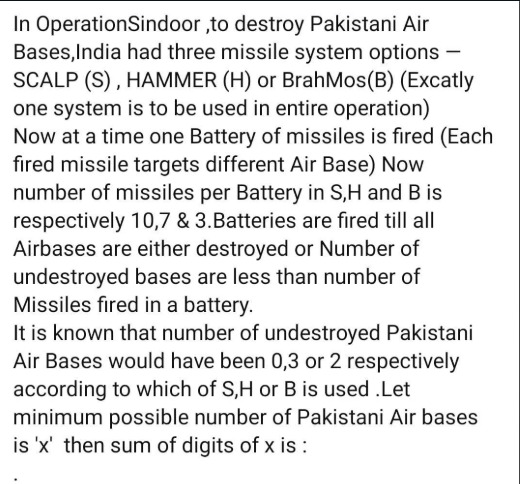Question
Question: In OperationSindoor, to destroy Pakistani Air Bases, India had three missile system options – SCALP ...
In OperationSindoor, to destroy Pakistani Air Bases, India had three missile system options – SCALP (S), HAMMER (H) or BrahMos(B) (Excatly one system is to be used in entire operation)
Now at a time one Battery of missiles is fired (Each fired missile targets different Air Base) Now number of missiles per Battery in S,H and B is respectively 10,7 & 3.Batteries are fired till all Airbases are either destroyed or Number of undestroyed bases are less than number of Missiles fired in a battery.
It is known that number of undestroyed Pakistani Air Bases would have been 0,3 or 2 respectively according to which of S,H or B is used .Let minimum possible number of Pakistani Air bases is 'x' then sum of digits of x is :

8
Solution
Let N be the initial number of Pakistani Air Bases. Let n be the number of missiles per battery for a given missile system. The operation fires batteries of n missiles until the number of undestroyed bases is less than n or is 0. Let U be the final number of undestroyed bases.
According to the rule, the operation stops when the number of undestroyed bases is less than n. Let Nrem be the number of undestroyed bases at some point. If Nrem≥n, a battery is fired, destroying n bases (assuming each missile targets a different base). The new number of undestroyed bases is Nrem−n. This process continues until the number of undestroyed bases is less than n. Starting with N bases, after firing k batteries, the number of undestroyed bases is N−kn. The operation stops after k batteries if N−(k−1)n≥n (so the k-th battery is fired) and N−kn<n (so the operation stops after the k-th battery). Let U=N−kn be the final number of undestroyed bases. The condition N−kn<n is U<n. The condition N−(k−1)n≥n becomes (N−kn)+n≥n, which is U+n≥n, or U≥0. This is always true since U is a number of bases.
So, the final number of undestroyed bases U is the remainder when N is divided by n, provided that the number of bases before the last step was at least n. Let N=qn+r, where 0≤r<n. If q≥1, then N=(q−1)n+n+r. After q−1 batteries, n+r bases remain. Since n+r≥n (as n≥3 and r≥0), the q-th battery is fired. After the q-th battery, r bases remain. Since r<n, the operation stops. So U=r. If q=0, then N=r, and 0≤r<n. In this case, no batteries are fired as the initial number of bases is already less than n. So U=N=r. In both cases, U is the remainder when N is divided by n, i.e., N≡U(modn), and 0≤U<n.
We are given the values of n and U for the three missile systems:
-
SCALP (S): nS=10, US=0. N≡0(mod10). This means N is a multiple of 10. N=10kS for some integer kS≥0. Since US=0, the operation stopped because all bases were destroyed. This implies that the number of bases before the last battery was exactly 10 (if kS≥1). If kS=0, N=0, US=0, which is consistent. If kS≥1, then N−(kS−1)10=10. 10kS−10kS+10=10. This is true for any kS≥1. So N must be a multiple of 10, N=10,20,30,….
-
HAMMER (H): nH=7, UH=3. N≡3(mod7). This means N can be written as N=7kH+3 for some integer kH≥0. The final number of bases is UH=3, which is less than nH=7. This is consistent with the stopping rule. The number of bases before the last battery must be at least 7. N−(kH−1)7≥7 (if kH≥1). (7kH+3)−(kH−1)7≥7 7kH+3−7kH+7≥7 10≥7. This is true for any kH≥1. If kH=0, N=3. Then UH=3, which is consistent (3<7). So, N must be of the form 7kH+3 where kH≥0, i.e., N=3,10,17,24,31,….
-
BrahMos (B): nB=3, UB=2. N≡2(mod3). This means N can be written as N=3kB+2 for some integer kB≥0. The final number of bases is UB=2, which is less than nB=3. This is consistent with the stopping rule. The number of bases before the last battery must be at least 3. N−(kB−1)3≥3 (if kB≥1). (3kB+2)−(kB−1)3≥3 3kB+2−3kB+3≥3 5≥3. This is true for any kB≥1. If kB=0, N=2. Then UB=2, which is consistent (2<3). So, N must be of the form 3kB+2 where kB≥0, i.e., N=2,5,8,11,14,17,20,23,26,29,32,….
The initial number of Pakistani Air Bases N must satisfy all three conditions simultaneously:
N≡0(mod10)
N≡3(mod7)
N≡2(mod3)
We need to find the minimum possible non-negative integer N that satisfies these congruences. This is a problem that can be solved using the Chinese Remainder Theorem, but we can also find the solution by checking values or by building up the solution.
From N≡0(mod10), N must be a multiple of 10. Possible values for N are 0,10,20,30,40,50,60,70,80,90,100,110,120,….
Now let's check which of these values satisfy N≡3(mod7):
0÷7 remainder is 0.
10÷7 remainder is 3. This satisfies the second condition.
Let's check if N=10 satisfies the third condition N≡2(mod3):
10÷3 remainder is 1. This does not satisfy the third condition.
Let's continue checking multiples of 10:
20÷7 remainder is 6. (No)
30÷7 remainder is 2. (No)
40÷7 remainder is 5. (No)
50÷7 remainder is 1. (No)
60÷7 remainder is 4. (No)
70÷7 remainder is 0. (No)
80÷7 remainder is 3. This satisfies the second condition.
Let's check if N=80 satisfies the third condition N≡2(mod3):
80=3×26+2. 80÷3 remainder is 2. This satisfies the third condition.
So N=80 satisfies all three conditions:
80≡0(mod10) (since 80=10×8+0)
80≡3(mod7) (since 80=7×11+3)
80≡2(mod3) (since 80=3×26+2)
Since we started checking from the smallest non-negative multiple of 10, the first value we found that satisfies all conditions is the minimum possible value of N.
So, the minimum possible number of Pakistani Air Bases is x=80.
The question asks for the sum of digits of x.
The digits of x=80 are 8 and 0.
The sum of the digits is 8+0=8.
The final answer is 8.
